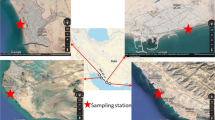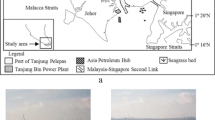Abstract
In the last decades, human and industrial activities in the coastal areas have increased and that resulted in different types of contamination, including trace elements. Therefore, investigations of the southeastern Adriatic marine environment quality are intensified following seawater, biota, and sediment quality related to metals pollution. Since standard chemical analysis methods cannot provide accurate information about concentrations of trace elements in seawater, the seagrass Posidoniaoceanica (L.) Delile and the mussel Mytilusgalloprovincialis Lamarck, 1819, were used as water pollution bioindicators for identifying, especially, toxic trace elements in the Mediterranean. Surface sediment, seawater, seagrass (P. oceanica), and mussel (M. galloprovincialis) samples were collected in different seasons from the coastal area of Boka Kotorska Bay in the last 10 years (2006–2016), and analyzed in order to determine the seawater quality mainly related to Fe, Mn, Zn, Ni, Cu, Co, Cd, As, Pb, and Hg. Based on the analysis of the metal pollution index values (MPIs) in both species the highest metal concentrations were measured in winters for most of the studied trace elements. The Hg accumulation in both investigated organisms was the lowest and almost the same.
Access provided by Autonomous University of Puebla. Download conference paper PDF
Similar content being viewed by others
Keywords
1 Introduction
Boka Kotorska Bay is located in Montenegro, in the southeastern Adriatic Sea. It is a semi-enclosed bay situated in the southeastern Adriatic Sea (Mediterranean Sea), along the Montenegro coastline. Given its natural and cultural values, it is on the UNESCO’s World Heritage List. The Boka Kotorska Bay was formed by fluvial erosion and the entrance width of the bay is 2.95 km; its coastline length is 105.7 km long and its total surface is 87.3 km2 with a maximal depth of about 70 m. The bay is naturally divided into four smaller bays: the Herceg Novi, Tivat, Risan-Morinj, and Kotor Bays. The bay contains submerged springs of freshwater, contributing to sediment resuspension, transport, and changing the deposition and distribution of trace metals into the water. Due to the specific geographical and hydrological structure of the bay, characterized by a low flow of water, the anthropogenic impact is pronounced [1].
The seagrass Posidoniaoceanica (L.) Delile and the mussel Mytilusgalloprovincialis (Lemarck, 1819) are part of the key bioindicator species which respond to the pollution of trace elements [2,3,4] in the Mediterranean, such as in the southeastern Adriatic Sea.
The mussel M. galloprovincialis is a native species of the Mediterranean, Black and Adriatic Seas, a sedentary, filter-feeding animal that through feeding not only assimilates the food necessary for growth and development but also accumulates contaminants present in the water column. This mussel is also a seafood product [5].
The protected P. oceanica is an endemic species in the Mediterranean and it can absorb trace elements directly from the water column or/and from interstitial water in sediments and has a high capacity for accumulating trace elements occurring in a marine environment [6].
The main goal of this study was to determine the concentrations of trace metals (Fe, Mn, Zn, Ni, Cu, Co, Cd, As, Pb, and Hg) in marine species, P. oceanica and M. galloprovincialis, in order to follow the marina pollution, and to compare these two species as bioindicators in the examined 10 years in different seasons and from four different locations in the bay. Based on the average trace-metal concentrations, the metal pollution indexes (MPIs) were determined for both species.
2 Materials and Methods
Seagrass was collected from four and mussels from nine different locations in the bay, in the winter, spring, and fall for the 2006 –2016 period, as indicated in Fig. 1.
Only at four locations it was possible to collect seagrass and mussels simultaneously. In these 10 years, the samples in the spring and fall were sampled shortly before the beginning and shortly after the end of summertime and tourist season, i.e., at the end of May and in the last week of September, respectively.
3 Results
The range of metal concentrations from minimum to maximum of Fe, Mn, Zn, Ni, Cu, Co, Cd, As, Pb, and Hg found in M. galloprovincialis (L.) and P. oceanica (L.) from the different locations and seasons is given in Tables 1 and 2.
On the basis of the average element concentrations, their order in the seagrass was the next: Fe > Mn > Zn > Ni > Pb > Co > Cu > Cd > As > Hg.
The average element concentrations in mussels are calculated, the same as in the P. oceanica, from three seasons at four locations in the period of 10 years, and their order was given as Fe > Zn > Mn > Ni > As > Co > Cu > Pb > Cd > Hg.
On the basis of the equation for the MPI, MPIs were counting for the seagrass and mussels:
where Cf1, Cf2… Cfn are the element concentrations and n is the number of investigated elements. The MPI values are shown in Table 3.
4 Discussion
In both species as the bioindicators, the highest metal concentrations were measured in winters for most of the studied trace elements. Mainly, the metal pollution index values (MPIs) found for M. galloprovincialis follow the sequence winter > fall > spring, and for P. oceanica, winter > spring > fall. The MPI values for the investigated organisms correspond to the degree of pollution level of the individual sites. The seagrass MPIs were almost three times higher than the mussel MPI values at the same location. It offers the possibility of monitoring the metal burden of the environment near seagrass meadows via MPI values for mussels. A large difference observed between MPI values for P. oceanica and M. galloprovincialis sampled at the same locations can be explained by P. oceanica trace element absorption from the water column and from surface sediments. This phenomenon may be one of the explanations for the disappearance of seagrass in the bay from the 70 s until now, when the bay was almost covered by meadows of P. oceanica. A significant surface reduction covered by this plant has been observed along the entire coastal area of Montenegro, too [7].
5 Conclusions
From the obtained MPI values, it is obvious that the mussel M. galloprovincialis is the better seawater bioindicator, while on the seagrass P. oceanica there are influences of heavy metals not only from seawater, but also from the surface sediment since MPIs were higher almost three times in the seagrass. These results could suggest the one more possible reason for the seagrass disappearance in the bay.
References
Bellafiore, D., Guarnieri, A., Grilli, F., Penna, P., Bortoluzzi, G., Giglio, F., Pinardi, N.: Stady of the hydrodinamical processes in the Boka kotorska Bay with a finite element model. Dyn. Atmos. Oceans 52, 298–321 (2011)
Stankovic, S., Kalaba, P., Stankovic, R.A.: Biota as toxic metals indicators. Rev. Environ. Chem. Lett. 12, 63–84 (2014)
Stanković, S., Stanković, R.A.: Green Materials for Energy, Products and Depollution, 1st edn. Springer, Dordrecht Heidelberg London New York (2013)
Perosevic, A., et.al.: The impacts of seawater physicochemical parameters and sediment metal contents on trace metal concentrations in mussels-a chemometric approach. Environ. Sci. Pollut. Res. 25, 28248–28263 (2018)
Stankovic, S., Jovic, M.: Health risks of heavy metals in the Mediterranean mussels as seafood. Environ. Chem. Lett. Rev. pap. 10(2), 119–130 (2012)
Jovic, M., Stankovic, S.: Determination of marine pollution bycomparative analysis of metal pollution indices. Arch. Biol. Sci. Belgrade 66(3), 1205–1215 (2014)
Mačić, V., Krivokapić, S.: In the handbook of environmental chemistry (No.54). The BokaKotorska Bay Environment, 1st edn. Springer, Switzerland (2016)
Author information
Authors and Affiliations
Corresponding author
Editor information
Editors and Affiliations
Rights and permissions
Copyright information
© 2021 The Editor(s) (if applicable) and The Author(s), under exclusive license to Springer Nature Switzerland AG
About this paper
Cite this paper
Stankovic, S., Perosevic, A., Pezo, L., Blagojevic, S., Onjia, A. (2021). Which Is a More Reliable Bioindicator—Mussels or Seagrass? A Case Study of the Toxic Metal Pollution in the Seawater of Boka Kotorska Bay, Adriatic Sea. In: Ksibi, M., et al. Recent Advances in Environmental Science from the Euro-Mediterranean and Surrounding Regions (2nd Edition). EMCEI 2019. Environmental Science and Engineering(). Springer, Cham. https://doi.org/10.1007/978-3-030-51210-1_342
Download citation
DOI: https://doi.org/10.1007/978-3-030-51210-1_342
Published:
Publisher Name: Springer, Cham
Print ISBN: 978-3-030-51209-5
Online ISBN: 978-3-030-51210-1
eBook Packages: Earth and Environmental ScienceEarth and Environmental Science (R0)





